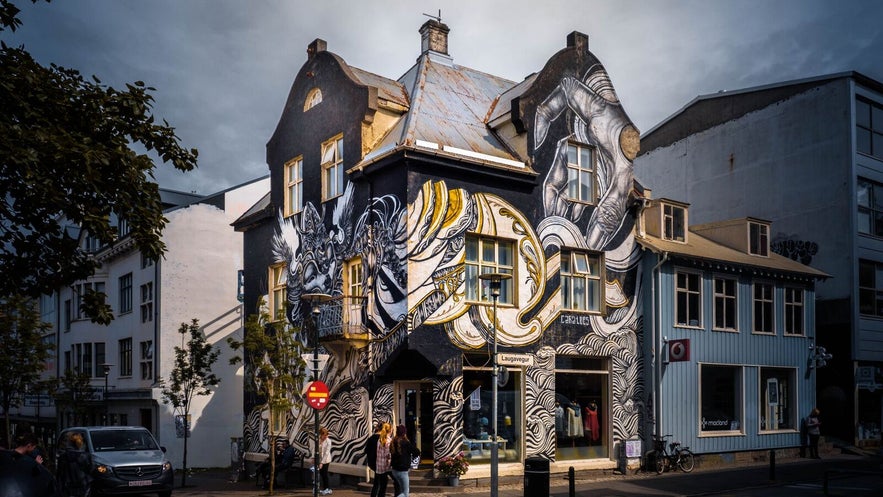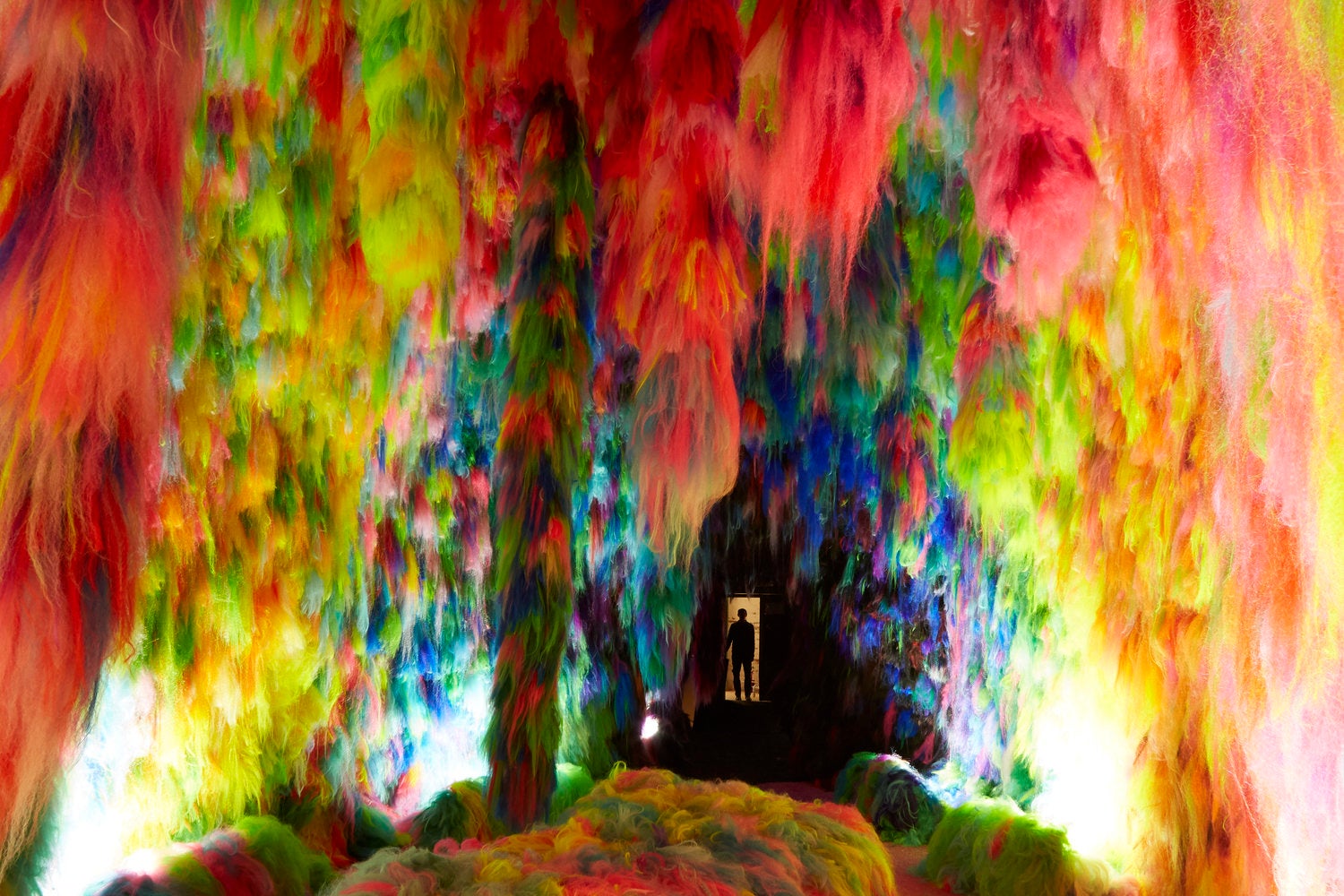Despite being the world's northernmost capital, Reykjavík is home to a thriving and prevalent street art scene. Where did it all begin and where does it go from here? Learn about Iceland's graffiti history and discover where to find the hidden gems that adorn the streets of Reykjavík City.
- Why don't you also check out The Best Art Museums and Galleries in Reykjavik
- For great discounts, purchase a Reykjavik City Card | 72 Hours
- Book this Best Value Northern Lights Bus Tour from Reykjavík
- Looking for close nature? The Golden Circle & Kerid Volcanic Crater | Small-Group Day Tour
From urban graffiti and rooftop tags to extravagant wall-murals, Reykjavík is so dotted with supreme street art that you can joyfully lose yourself for days in the sweeping sea of creativity.
Why You Can Trust Our Content
Guide to Iceland is the most trusted travel platform in Iceland, helping millions of visitors each year. All our content is written and reviewed by local experts who are deeply familiar with Iceland. You can count on us for accurate, up-to-date, and trustworthy travel advice.
We took a guided stroll through downtown Reykjavík with Örn Tönsberg (a.k.a. Selur), one of the city’s leading street artists, and invite you to join us on a thrilling journey through Reykjavík's street art and urban culture.
Video footage from our personal graffiti tour with local street artist Selur
Despite a history that dates back thousands of years, graffiti in its modern form originated on the streets of Philadelphia and New York in the late 1960s, when local gangs would tag Subway carts with district news and territorial markings.
But as with most things, the rebel art form only started to root in the then geographically and culturally isolated Iceland a bit later. In the early 1990's, Icelandic teens worked with the little they could scrape together and started to develop their own style—short of the benefits of the internet, a couple of photo books, album covers and music videos became their bibles.
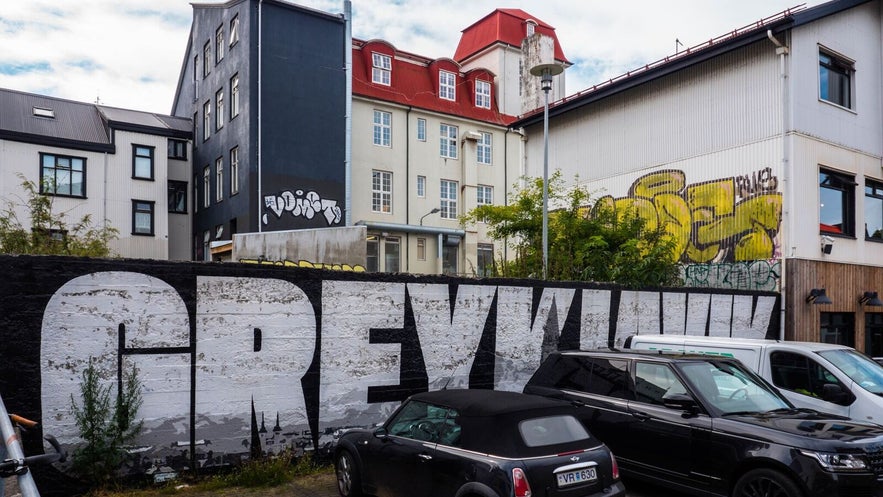
Street art has many faces, but the two we will be focusing on here are tags and murals. A tag is a signifier of someone’s name or nickname, be it an individual or a gang of many.
Tags are most often produced in a bubble-like form of lettering that throughout the years has reached its own peaks of aestheticism. Tags are generally considered vandalism, and taggers are known to alter their specifics to throw the police off the track.
Murals, however, are more colourful and complex, they are often commissioned, and are generally believed to beautify the community. What unites these two poles in a single spectrum, is that their canvas is the city itself and its public spaces.
People are used to art being confined and controlled in conventional settings such as museums or galleries. But in the case of street art, it is the art that approaches the viewer, instead of the other way around.
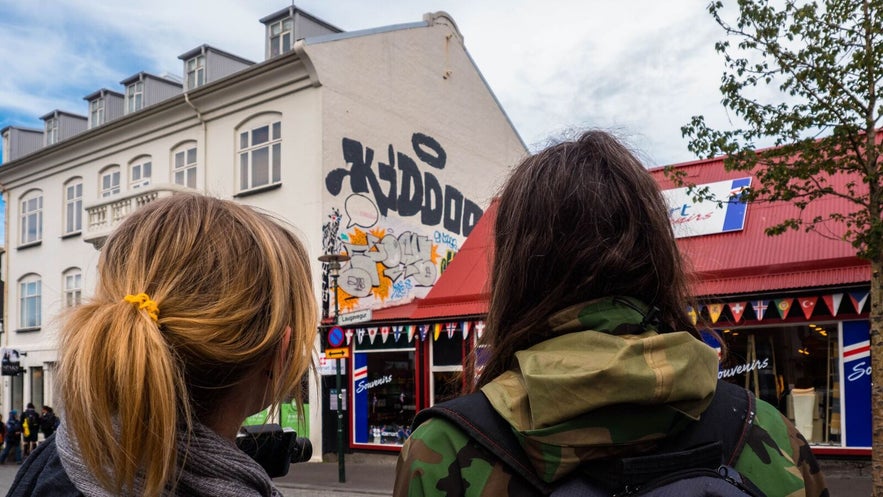
Because of the confronting mode by which this artistic expression is often conveyed, many people are culturally conditioned to see graffiti strictly as an invasion and a form of vandalism; it shows up unexpectedly and without warning.
But perhaps therein lies the very essence of its appeal and artistic merit; graffiti drags you out from the comfort zone of normality without asking your permission.
Although most Icelanders would rightly oppose to the idea of their house being covered in unwanted tags, there is no denying street art is enjoyed in Reykjavík and relished by the community, be it properly done and at optimised locations.
Downtown Reykjavík today boasts of several establishments that embrace graffiti both outside and inside their doors; you'll find commissioned works by Margeir Dire outside Bar Ananas, while Geoffrey Skywalker, Arnór Kári, the HNP-Crew and others went nuts with a spray can inside Freddi Arcade. Prikið is also a classic spot, currently donning works by KIDDUST and UglyBrothers, just to name a few.
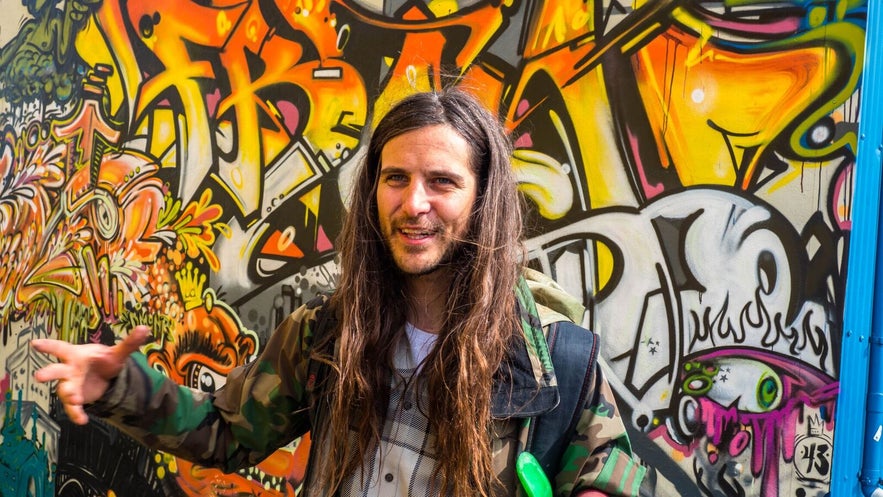
Our journey begins in one of these graffiti-friendly venues, at a local dive bar, Gaukurinn, where the street artist known as Selur greeted us through the fumes as he was finishing up a large mural of a bird in the establishment’s staircase.
Seemingly satisfied with the results, he put down his spray can, grabbed his penny board and lead us out onto the sun-drenched streets of Reykjavík City, to better acquaint us with the treasure trove of street art and graffiti that bejewels the streets of the capital.
- See also: Secret Spots & Hidden Gems in Reykjavík
"The spray can is just a tool" Selur answered when asked about the difference between street art and graffiti. "It's a tool in the same way as a knife; you can use it like the chef or like the butcher. To make something good or something bad."
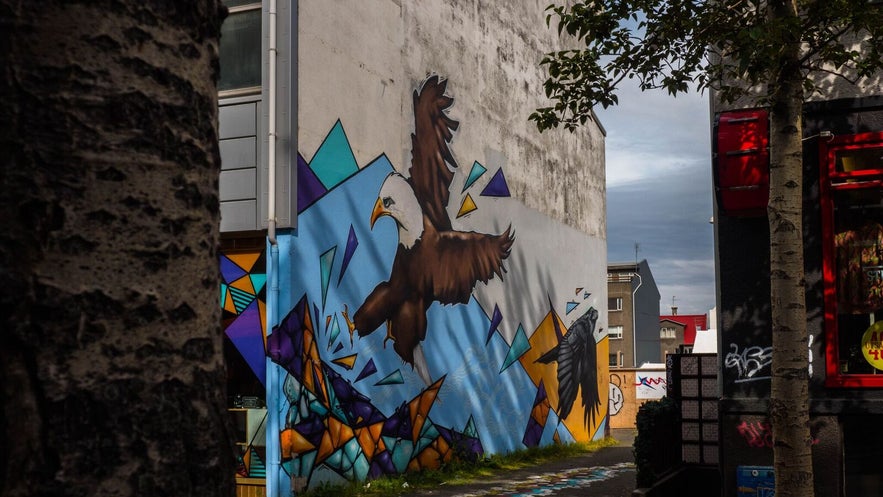
“I really don’t know what I’m doing; if it’s art, graffiti, street art, mural painting, whatever you call it. Graffiti is just an umbrella term. I don’t care what you call it, as long as it’s made with beauty in mind. Then it’s fine by me.”
Since beauty is in the eye of the beholder, there’s no wonder that different forms of street art have both advocates and opponents, admirers and adversaries, lovers and haters.
But graffiti is here to stay. It’s an organic, continuously developing form of art that will forever continue to grace urban landscape with its presence, no matter how many coats of paint are used to try to suffocate it.
So let’s get to exploring the many marvels of Reykjavík's streets.
Wallpoetry | Bringing Berlin to Reykjavik
A behind-the-scenes look at the Wallpoetry project during preparations for Iceland Airwaves 2016
As visitors to Iceland in the last couple of years are sure to have noticed, several large and elaborate murals adorn the walls of buildings in and around Reykjavík’s centre. Most of these are the results of the authorised collaborations of two different groups; music festival Iceland Airwaves, and contemporary art initiative Urban Nation of Berlin.
The idea behind the project, branded Wall Poetry, is one of beauty and advocacy: to reconnect music makers with visual artists. Remember when album covers were as much part of record releases as the music within? In the current age of downloading, that kinship feels somewhat lost.
- See our collection of articles on Music in Iceland
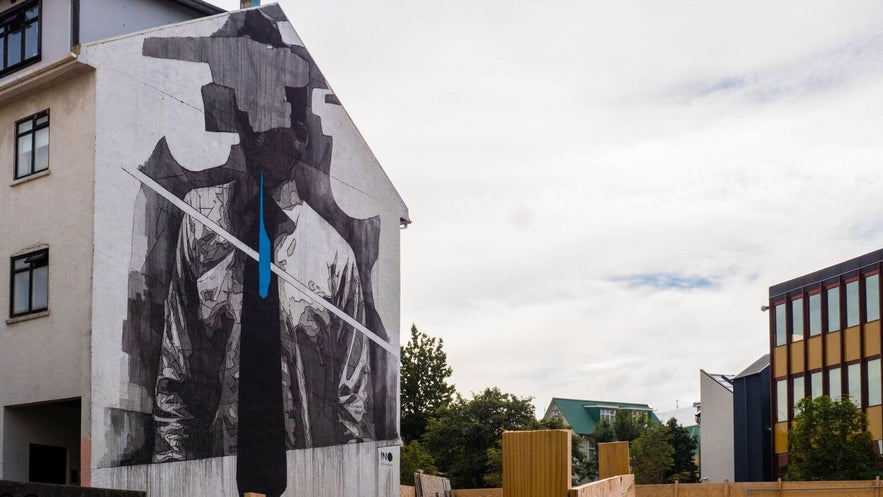
Yasha Young, curator and head of Urban Nation, set out to rekindle that connection. In 2015, she invited ten international street artists to Iceland and paired them with ten musicians performing at the Airwaves festival.
The audio artists provided their visual-medium counterparts with a song, title, quote, poem, or book that greatly influenced their music. That way the written and spoken word also got to be a part of the mix, resulting in stunning pieces of wall poetry.
The project was so fruitful and well-received that it was repeated the following year.
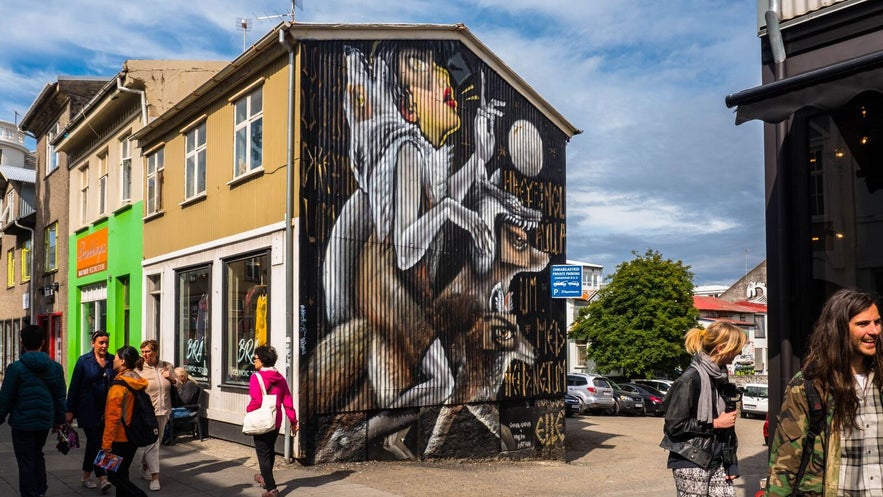
Is this sophisticated venture the ultimate example of a city embracing its street art? Although Selur and many others within the street art scene are big fans of some of these works, he also mentions how Icelandic street artists weren’t invited to partake in the project.
It is impressive and beautifying for sure, but as a spelling error in the D*FACE Laxdæla Saga mural in central Reykjavík demonstrates, these are not local works.
- See also: Icelandic Literature for Beginners
“It’s as if the Airwaves murals have taken over. Not much is happening regarding graffiti in the street scene today.” That doesn’t mean the murals themselves are to blame, Selur adds—the fact of the matter is that urban planning in Reykjavík is simply too hurried these days for any other wall art to be allowed to linger.
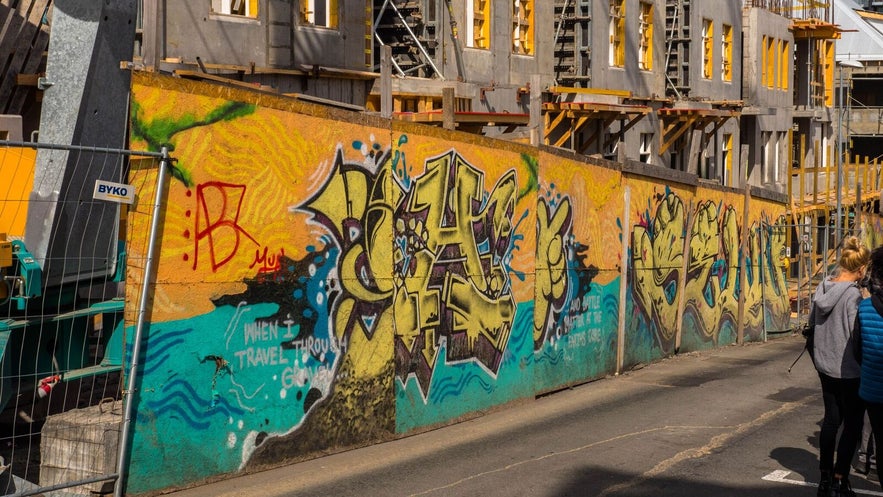
And sure enough, as we walked through the city centre, there didn’t seem to be a corner that was not under construction. Building cranes hovered over our heads and the rattling of machines filled the air; walls were being torn down and streets were being paved to embrace new housing complexes and hotels.
“This city is getting too clean” Selur jestingly remarked. “That’s the downer of painting these walls—most of them are a part of construction sites, so they won’t get to live on.”
And the few walls that aren’t set up for demolition seem reserved for the Wallpoetry Project, meaning there's not much else that gets a chance.
- See also: 7 Things Icelanders HATE about Tourism in Iceland
All the same, the effects of the affair are undeniable. With the buildings of Reykjavík acting as canvases, the capital received the makeover it deserved. These murals represent art that is brought out into the open for everyone to enjoy.
Reykjavik Murals & Commissioned Graffiti
Despite the great prominence of the Wallpoetry murals, in no way are they the only grand wall-works in the city of Reykjavík. In the centre, for instance, you’ll find multiple pieces by Sara Riel, whose methods are quite demonstrative of battling the legal grey zone of street art.
Sara Riel is a multifaceted artist from Iceland with a degree from Weißensee University of Arts in Berlin. Her works include graphic design, illustrations, cartoons, paintings and photography, but she is best known for her graffiti murals.
When creating her murals, Sara at first attempted to do so legally. She would send forms and requests to city officials, asking for permission or funding. As time went on without any answers, she took matters into her own hands and asked house owners directly for permission. She then went ahead with the projects and initially ended up self-funding all of her work.
This vigilant method seemed to do the trick since her murals still stand—never painted over by city officials. When scouting the capital, you should easily recognise Sara’s work by her distinctive style, which seems to walk the fine line between visual art and graphic design.
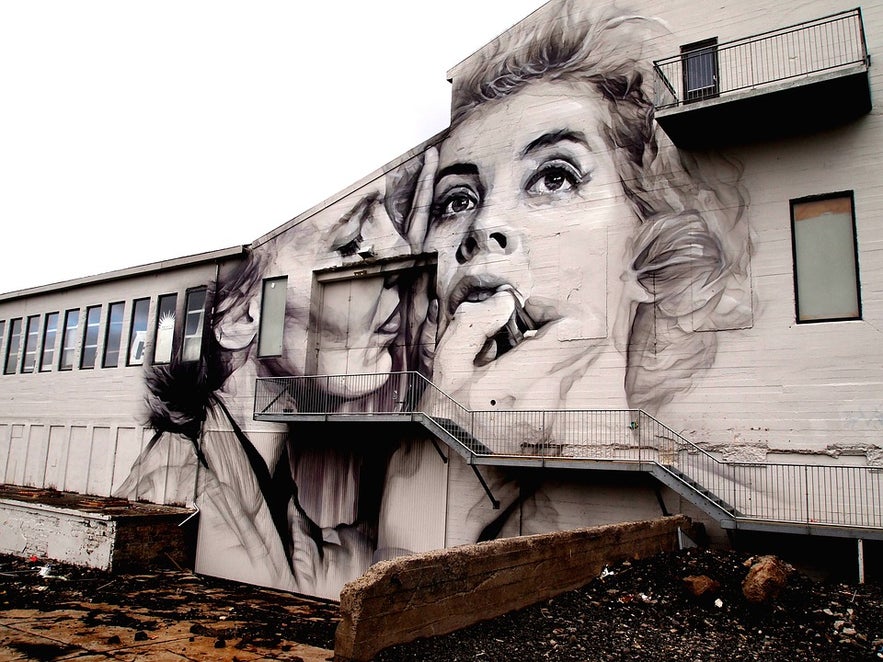
If we venture a bit beyond the city centre, we reach Grandi, a harbour area of fish-packing factories that has impressively gravitated from industry to culture in the last couple of years. Nowadays, you'll find the sector filled with boutiques, galleries, museums, cafés, and monumental black and white wall-murals by Guideo Van Helten.
The renowned Australian artist based these spectacular works on snap-shots by Andrés Kolbeinsson, collected from the Reykjavík Museum of Photography. The original photographs all portray Icelandic actors in a local 1961 production of Jean-Paul Sartre's No Exit, an existentialist play revolving around three souls stuck together in the afterlife.
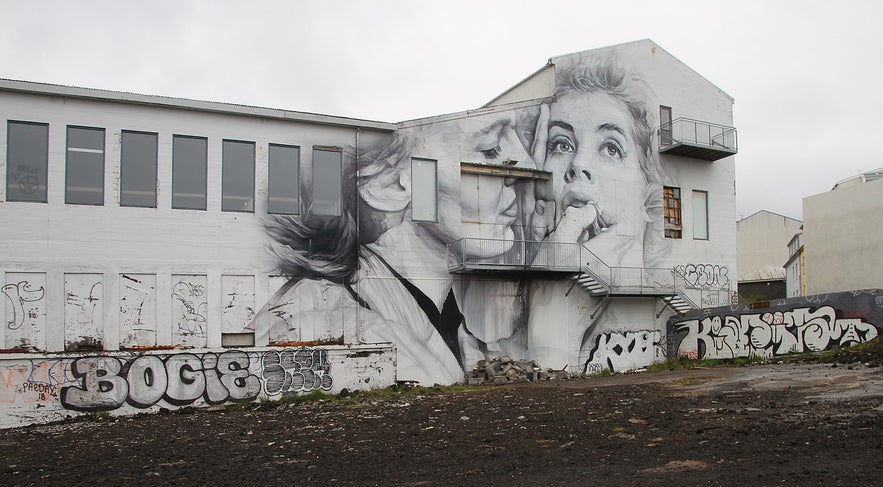 Photo from Wikimedia, Creative Commons, by Gerd Eichmann. No edits made.
Photo from Wikimedia, Creative Commons, by Gerd Eichmann. No edits made.
Van Helten is today known throughout the world for his photorealistic murals, as he travels the globe on commissioned projects. But in his youth, he was a graffiti artist.
Wherever he goes, he immerses himself in the native culture, to truly present the locals with artistic and authentic escapism, filled to the brim with cultural and philosophical references. The Grandi area has arguably never looked as enchanting as it now does with Van Helten's decorations.
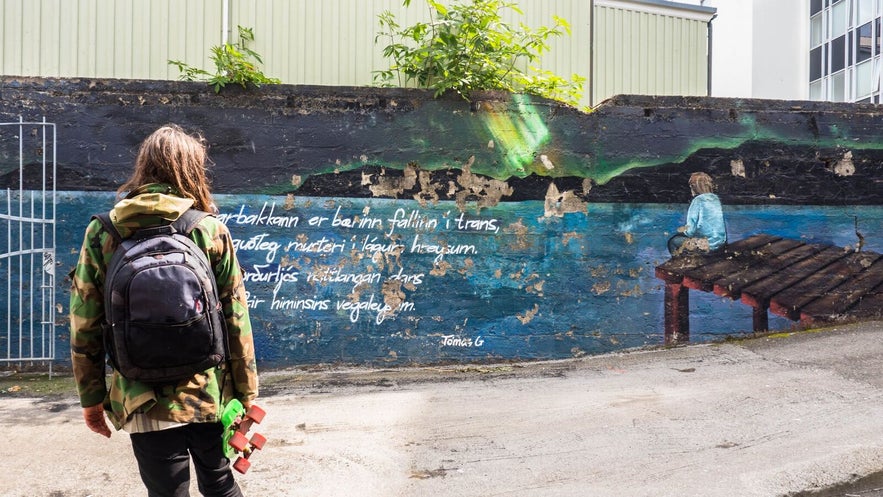
The murals of the city come and go, commissioned through projects aimed at beautifying the capital. Enterprises such as Glaðari gaflar (happier corners) in 2009 and the infamous Erró murals in Breiðholt District in 2014 are compelling examples of the city's different approaches to official street art.
The former was an open competition with a budget of 300.000 ISK, and the latter a mural making for a Reykjavík suburb, consisting of pieces produced by the world-renowned artist, Erró, with costs reaching over 50 million ISK.
With such numbers at hand, it is almost comical how much money the city actually spends in its attempts to annihilate unwanted graffiti. Clean-up acts such as Hrein borg (clean city) from 2008 might have served to wipe out a great deal of urban tagging—but for the handsome sum of 156 million ISK, and of course yielding only temporary results. When there's a war, can anyone really win?
Unwanted Graffiti & The Issue of Vandalism
WUGO & DUST (KIDDUST) members of crews RWS & MLC doing what they do best
For such a small capital, Reykjavík seems to have no shortage of taggers and tag crews that compete in leaving their markings territorially around the city. Although the city has a long history of waging a costly war against such forms of graffiti— spending millions in cleanups and hunting down taggers—vast areas of the community seek to reach a middle ground.
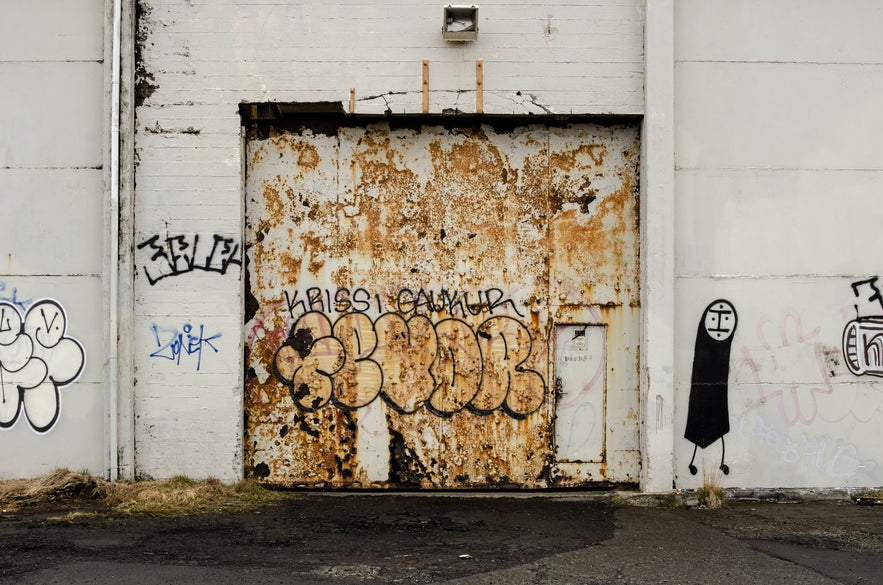 Photo by Renard Roux
Photo by Renard Roux
Uncommissioned graffiti tends to pop up in places that urban planning forgot; in underpasses, abandoned complexes, on temporary construction walls and run-down parking lots. An excellent example of such a venue would be the underpass of Miklabraut Road, next to Klambratún Park, known as Hlíðargöngin.
When Reykjavík's underground graffiti culture was in its prime in the late 1990's, fueled by the locally dominant hip hop scene, this tunnel was at all times a mecca of urban masterpieces. Graffiti was very much illegal during those years, so why was this particular venue left in peace?
It mostly came down to the efforts of one man, Jóhann "Jói" Jónmundsson, a city official who was a warden of the tunnel's bathrooms between 1993-2005.
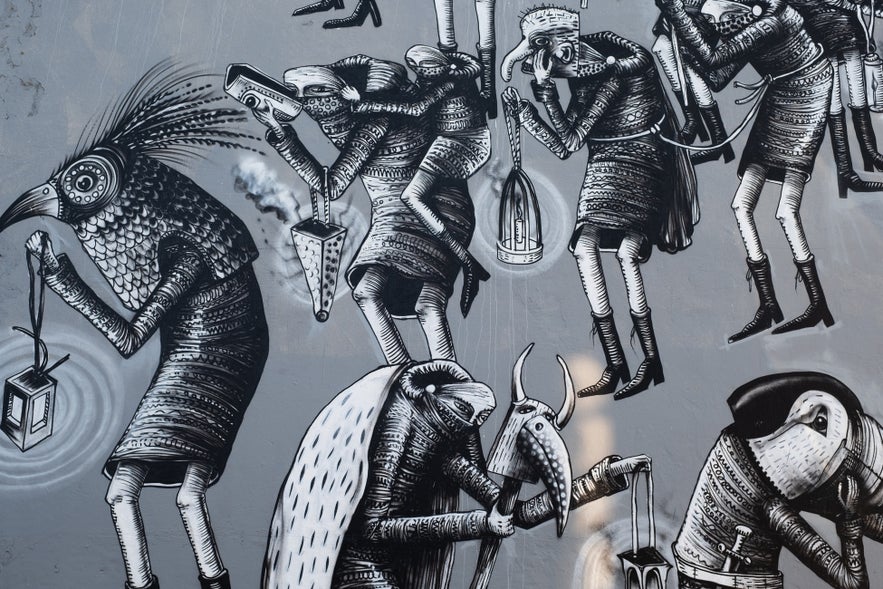 Photo by Lance Anderson
Photo by Lance Anderson
The story goes that at first, Jói did his job dutifully and painted over whatever the kids would spray. He would then show up the next day and notice three new pieces in the original's place. Some of them, he noticed, were exceptional works of art, so Jói made a deal with his supervisors that has gone down in urban history.
J´oi became something of an underground curator and the tunnel venue was granted an exception to the rules. Jói would manage the graffiti and keep it within moral limits; nothing overtly obscene or pornographic would be allowed to linger, but everything else could stay.
The results were nothing short of amazing, but the golden years came and went. With Jói gone, the tunnel went through multiple periods during which the graffiti was painted over, only to see less aesthetic tags take their place within a matter of days.
In 2015, all that changed, as Reykjavík's annual Culture Night (Menningarnótt) saw a group of graffiti artists gather to yet again bring life to the walls of the tunnel.
Footage from Hlíðargöngin on Culture Night 2015 by Noumena Films
These included current street artists Dire and Chulo, along with old-timers such as Youze, Atom, Kez and others. The event served as a reunion for the veterans as well as a convention for the currently active. The city gracefully permitted the affair and music echoed in the underpass all through the night.
Ellen Guðmundsdóttir, a local advocate of graffiti and youth culture, had in 2014 suggested that the city should permanently allow Hlíðargöngin to serve as a haven for graffiti artists. She claimed it would prevent the spread of unwanted vandalism while allowing upcoming talent—those not yet seasoned enough to be granted elaborate murals—to practice their art in a safe space.
A zero tolerance attitude is not only expensive and momentary, it ignores the young artists that are expressing themselves. "The issue is a social one," says Ellen. "These kids want to be heard and appreciated for their art, same as the ones who get a round of applause and approval for playing musical instruments."
Ellen and many others see the underpass of Hlíðargöng as the perfect location for permitted leniency. The so-called spillover effect gets prevented because of the tunnel's enclosure—and if the better works are allowed to live, they are much less likely to be sprayed over.
TreasuresLost, Remembered and Regained
Music video by local artist Futuregrapher shot in Hjartagarðurinn
If you visited Reykjavík at any point during the period of 2009-2014, you might have noticed one of the downtown's most alluring locations behind Laugavegur 21, known as Hjartagarðurinn or the 'Heart Park'. This unofficial cultural heritage site was born out of the economical crash of 2008 when the construction of a shopping mall had to suddenly be halted due to lack of sufficient funds.
Where some saw a desolate and run-down site of abandoned buildings, graffiti artists saw the perfect canvas. Soon enough, the park became an explosion of colours as the idea spread like wildfire within the scene.
In 2011, three artists took it upon themselves to communally clean up the park and make it family-friendly by adding a playground, a skate-park, a DJ booth, a stage, picnic tables and benches.

These artists were Tanya Pollock, Tómas Magnússon and our trusted guide, Örn Törnsberg (Selur). The park was an unexampled success, where locals and foreign visitors flocked on a daily basis to enjoy the scene, the culture, the art and the sun.
Despite noble efforts to protect the park, it was eventually demolished and a cemented hotel plaza has now taken its place. The locals still mourn their beloved Heart Park, but perhaps the park's story simply represents the fleeting nature of graffiti itself.
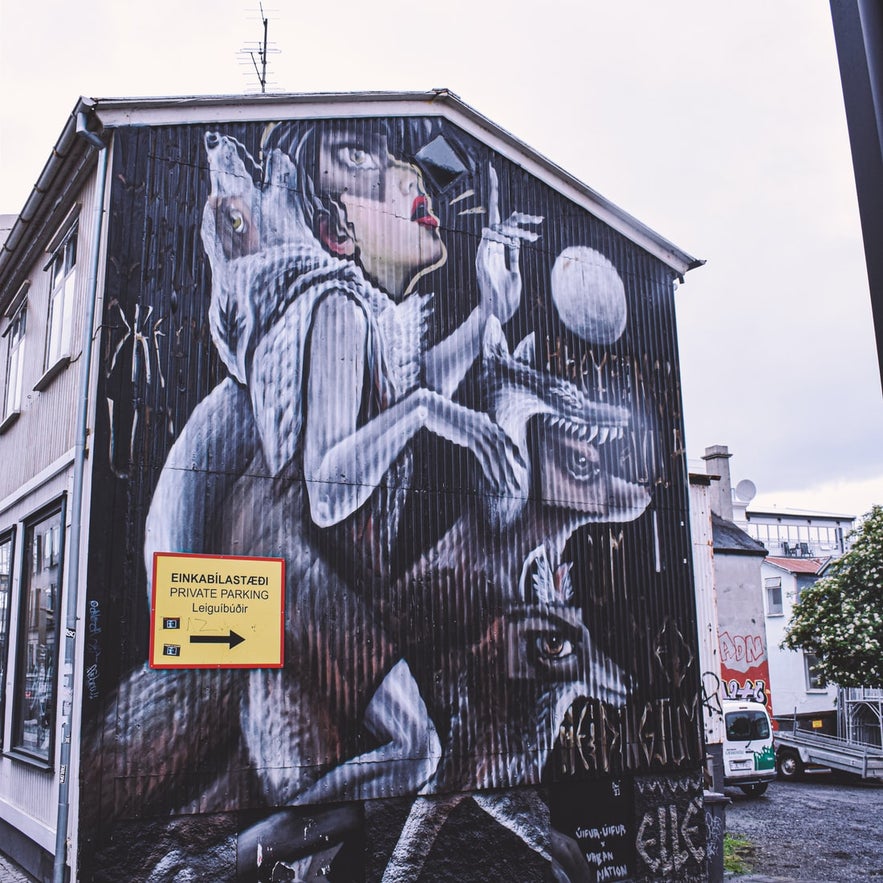 Photo by David Bayliss
Photo by David Bayliss
One of the main traits of graffiti as an art form is that it's temporary. Perhaps it is also one of its leading allures—it is here today but might be gone tomorrow.
The achievement of a piece requires a significant amount of planning and effort, as well as the quintessential run-in with the law. Still, all the efforts of the artists involved might be wiped out in an instant with a fresh coat of paint.
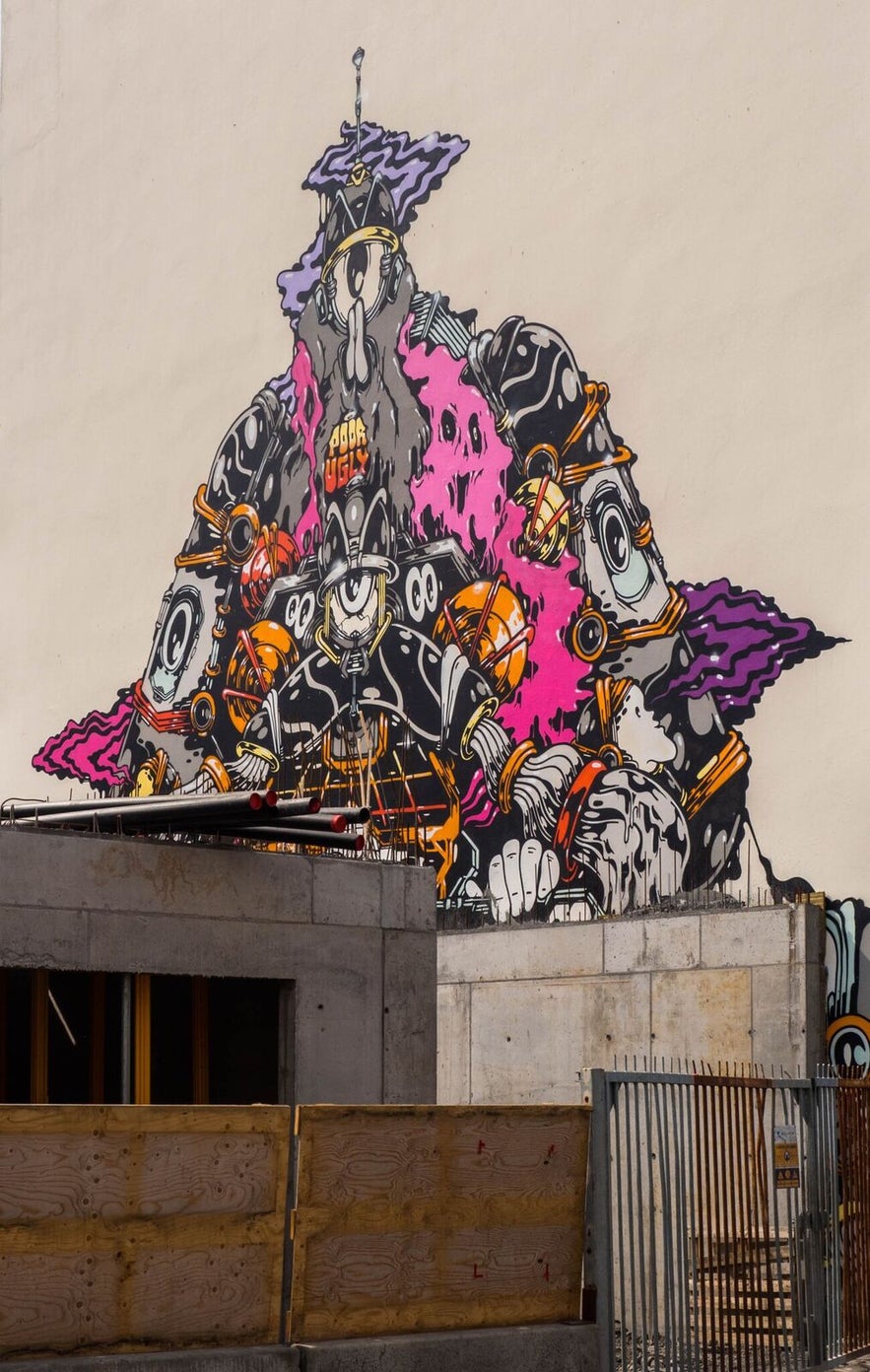
"It's all disappearing", said Selur as we trailed pass construction sites that used to harbour his and others' collaborative works of street art. "But that's fine, it's all temporary. It's not supposed to live forever, it's supposed to rotate."
Galleries don't host the same exhibitions eternally, and the streets are no exception.
Reykjavík is a living, breathing city going through constant changes. The capital's graffiti serves as a visual reminder of this fluxation, as it tends to pop up in locations that time has momentarily forgotten; locations in a limbo awaiting construction or destruction.
"New things can now take their place" Selur concludes with a sly smile, most likely thinking of fresh pieces he has in mind. Street art, by nature, takes its viewer by surprise. It shows up where it's not meant to, and disappears when you least expect it.
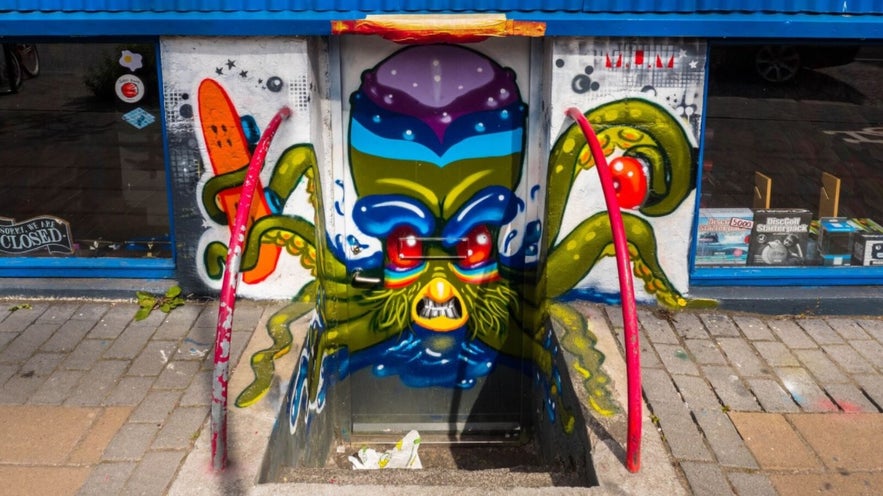
The only thing permanent in terms of Reykjavík's street art is its very presence. Although the individual venues and murals might go away, there will always be others to replace them. As long as a city has citizens, it will never run out of graffiti.
The artists will continue to do what they have always done, providing the rest of us with the ever-evolving art form of urban upheaval. It's best to simply enjoy it while it's there.
Did you enjoy our guide to the street art of Reykjavík? What are some of your favourite pieces? Do you feel the graffiti to be a part of the city? Let us know what you think in the comments box below!

